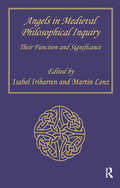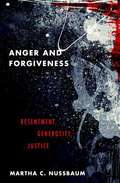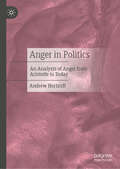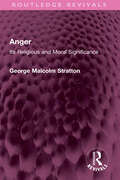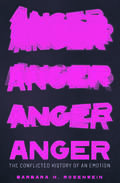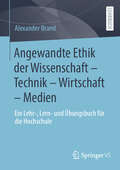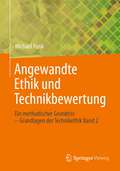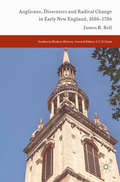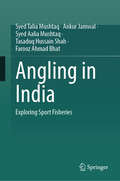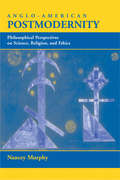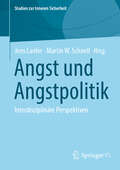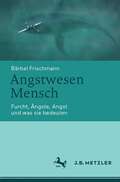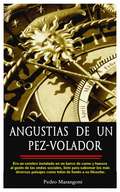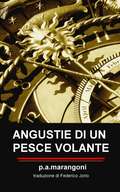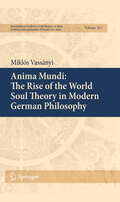- Table View
- List View
Angels in Medieval Philosophical Inquiry: Their Function and Significance (Ashgate Studies In Medieval Philosophy Ser.)
by Martin LenzThe nature and properties of angels occupied a prominent place in medieval philosophical inquiry. Creatures of two worlds, angels provided ideal ground for exploring the nature of God and his creation, being perceived as 'models' according to which a whole range of questions were defined, from cosmological order, movement and place, to individuation, cognition, volition, and modes of language. This collection of essays is a significant scholarly contribution to angelology, centred on the function and significance of angels in medieval speculation and its history. The unifying theme is that of the role of angels in philosophical inquiry, where each contribution represents a case study in which the angelic model is seen to motivate developments in specific areas and periods of medieval philosophical thought.
Anger and Forgiveness: Resentment, Generosity, and Justice
by Martha C. NussbaumAnger is not just ubiquitous, it is also popular. Many people think it is impossible to care sufficiently for justice without anger at injustice. Many believe that it is impossible for individuals to vindicate their own self-respect or to move beyond an injury without anger. To not feel anger in those cases would be considered suspect. Is this how we should think about anger, or is anger above all a disease, deforming both the personal and the political? <p><p> In this wide-ranging book, Martha C. Nussbaum, one of our leading public intellectuals, argues that anger is conceptually confused and normatively pernicious. It assumes that the suffering of the wrongdoer restores the thing that was damaged, and it betrays an all-too-lively interest in relative status and humiliation. Studying anger in intimate relationships, casual daily interactions, the workplace, the criminal justice system, and movements for social transformation, Nussbaum shows that anger's core ideas are both infantile and harmful. <p> Is forgiveness the best way of transcending anger? Nussbaum examines different conceptions of this much-sentimentalized notion, both in the Jewish and Christian traditions and in secular morality. Some forms of forgiveness are ethically promising, she claims, but others are subtle allies of retribution: those that exact a performance of contrition and abasement as a condition of waiving angry feelings. In general, she argues, a spirit of generosity (combined, in some cases, with a reliance on impartial welfare-oriented legal institutions) is the best way to respond to injury. Applied to the personal and the political realms, Nussbaum's profoundly insightful and erudite view of anger and forgiveness puts both in a startling new light.
Anger in Politics: An Analysis of Anger from Aristotle to Today
by Andrew HertzoffAnger is everywhere today. Why is there so much anger in our politics? Why do some things feed unreasonable rage, and other outrageous things fail to provoke outrage? What should we be angry about and how? Some see anger as a toxic force endangering political debate, democracy, and civil society; others see anger as a the only proper motivation to pursue injustice. In this debate, Hertzoff offers considerations grounded in Aristotle&’s treatment of anger. When, why, and in what ways we become angry need to be judged against a standard of virtuous anger, measured against concepts of justice, dignity, and nobility. In bringing together Aristotle&’s concept and treatment with our concerns with anger in our society gives us reason to rethink our views of anger, how we learn to be angry, and how we teach children to be angry properly .
Anger, Fear, Domination: Dark Passions and the Power of Political Speech
by William A. GalstonA renowned political theorist offers a road map to the dark forces that threaten democracy Liberalism orients itself around the idea of self-interest tempered by reason, with the addition of civically useful emotions such as patriotism, self-sacrifice, and empathy. But the politics dominating much of the world shows that these ideals are not enough. William A. Galston argues that the defense of liberal democracy requires understanding the dark forces whose impact on political life liberal democratic institutions seek to mute: the emotions of fear, humiliation, anger, resentment, and hatred, and the drive to dominate. In hard or threatening times, it is these dark passions that most reliably persuade people and move them to action—whether voting or violence. Throughout the democratic world, these institutional defenses are now being tested by a new generation of demagogues. With a keen awareness of the stakes, Galston explains why countering this dangerous development requires not only more responsive public policies but persuasive rhetoric and a realistic conception of political psychology—one that is free of the illusion that reason or affirmative sentiments such as empathy, solidarity, and love can reliably dominate public affairs.
Anger, Mercy, Revenge (Complete Works Of Lucius Annaeus Seneca Ser.)
by Lucius Annaeus SenecaLucius Annaeus Seneca (4 BCE–65 CE) was a Roman Stoic philosopher, dramatist, statesman, and adviser to the emperor Nero, all during the Silver Age of Latin literature. The Complete Works of Lucius Annaeus Seneca is a fresh and compelling series of new English-language translations of his works in eight accessible volumes. Edited by world-renowned classicists Elizabeth Asmis, Shadi Bartsch, and Martha C. Nussbaum, this engaging collection restores Seneca—whose works have been highly praised by modern authors from Desiderius Erasmus to Ralph Waldo Emerson—to his rightful place among the classical writers most widely studied in the humanities.Anger, Mercy, Revenge comprises three key writings: the moral essays On Anger and On Clemency—which were penned as advice for the then young emperor, Nero—and the Apocolocyntosis, a brilliant satire lampooning the end of the reign of Claudius. Friend and tutor, as well as philosopher, Seneca welcomed the age of Nero in tones alternately serious, poetic, and comic—making Anger, Mercy, Revenge a work just as complicated, astute, and ambitious as its author.
Anger: Its Religious and Moral Significance (Routledge Revivals)
by George Malcolm StrattonFirst published in 1923, Anger presents some considerations of anger where it comes close to conduct and religion. It is hoped that the explanation of conscience, and of the origins of religion, and particularly of monotheism has been carried a firm step farther than hitherto, and that interest will be found in the novel grouping of the great faiths with respect to wrath. The spirit of the great religions is drawn from their sacred writings. This book will be of interest to students of philosophy and religion.
Anger: The Conflicted History of an Emotion (Vices and Virtues)
by Barbara H. RosenweinTracing the story of anger from the Buddha to Twitter, Rosenwein provides a much-needed account of our changing and contradictory understandings of this emotion All of us think we know when we are angry, and we are sure we can recognize anger in others as well. But this is only superficially true. We see anger through lenses colored by what we know, experience, and learn. Barbara H. Rosenwein traces our many conflicting ideas about and expressions of anger, taking the story from the Buddha to our own time, from anger&’s complete rejection to its warm reception. Rosenwein explores how anger has been characterized by gender and race, why it has been tied to violence and how that is often a false connection, how it has figured among the seven deadly sins and yet is considered a virtue, and how its interpretation, once largely the preserve of philosophers and theologians, has been gradually handed over to scientists—with very mixed results. Rosenwein shows that the history of anger can help us grapple with it today.
Angewandte Ethik der Wissenschaft – Technik – Wirtschaft – Medien: Ein Lehr-, Lern- und Übungsbuch für die Hochschule
by Alexander BramlDieses Buch bietet eine knappe und verständliche Einführung in die theoretischen Grundlagen der Ethik und gleichzeitig in ihre wichtigsten praktischen Felder Wirtschaft, Wissenschaft, Technik und Medien. Konkrete Bezüge zu Fragen unseres Lebens und Alltags werden anhand aktueller und relevanter Fragestellungen erarbeitet. Literaturhinweise zu jedem Kapitel laden zum Weiterlesen, Anschlussfragen an die Anwendungsfelder zum Diskutieren und Weiterdenken ein.
Angewandte Ethik in der Neuromedizin
by Ralf J. Jox Frank ErbguthDas Praxisbuch zeigt anhand verschiedener klinischer Situationen in der Neuromedizin, wie die wissenschaftliche Reflexion auf dem Gebiet der Neuroethik praktisch angewendet werden kann. Es richtet sich prim#65533;r an #65533;rzte sowie alle anderen Gesundheitsberufe, die in Neurologie, Neurochirurgie oder Neuroradiologie mit ethischen Fragen konfrontiert sind, die sich speziell in ihrem T#65533;tigkeitsbereich ergeben. Indem es den klinischen Kontext in den Blick r#65533;ckt, schlie#65533;t das Werk die L#65533;cke zwischen Einf#65533;hrungsb#65533;chern und wissenschaftlichen Handb#65533;chern zur Neuroethik. Der Themenkanon umspannt die wesentlichen relevanten Felder der Neuroethik von der klinischen Ethikberatung bis zu einzelnen ethischen Fragen in der Neurodiagnostik, bei Neurointerventionen und in speziellen neuroklinischen Situationen. Herausgegeben von einem wissenschaftlich t#65533;tiger Ethiker und Neurologen und einem Krankenhausneurologen, wirken an dem Buch Experten aus verschiedenen Disziplinen und L#65533;ndern mit.
Angewandte Ethik in der Neuromedizin
by Ralf J. Jox Frank ErbguthAnhand ausgewählter klinischer Situationen in der Neuromedizin zeigt dieses Buch, wie die wissenschaftliche Reflexion auf dem Gebiet der Neuroethik praktisch angewendet werden kann. Es richtet sich primär an Ärztinnen und Ärzte sowie an alle anderen Gesundheitsberufe, die in den Bereichen der Neuromedizin mit ethischen Fragen konfrontiert sind, die sich speziell in ihrem Tätigkeitsbereich ergeben. Indem es den klinischen Kontext in den Blick rückt, schließt das Werk die Lücke zwischen Einführungsbüchern und wissenschaftlichen Handbüchern zur Neuroethik. Das breite Themenspektrum wurde für die vollständig aktualisierte 2. Auflage um ein Kapitel zum gegenwärtigen Einsatz von Künstlicher Intelligenz in der Neuromedizin erweitert. Herausgegeben von einem Krankenhausneurologen und einem wissenschaftlich tätigen Neuroethiker, enthält das Buch Beiträge von Expertinnen und Experten aus verschiedenen Disziplinen und Ländern.
Angewandte Ethik und Technikbewertung: Ein methodischer Grundriss – Grundlagen der Technikethik Band 2
by Michael FunkWie bilde ich mir ein ethisches Urteil, um Konflikten zu begegnen? Was ist Technik und wer ist verantwortlich, wenn sie versagt? Stehen Menschen noch im Mittelpunkt – obwohl oder gerade weil Maschinen immer „smarter“ werden? Fragen wie diese verlangen nach einer übersichtlichen und verständlichen Präsentation ethischer Methoden der Technikbewertung. Dabei rückt vorliegendes Buch die Auseinandersetzung mit den Folgen, Risiken und Nebeneffekten technischen Handelns in den Mittelpunkt. Diese reichen von ökologischen Fragen der Entsorgung über Zweckentfremdung bis hin zur individuellen und kollektiven Verantwortung von Ingenieur*innen. Aufbauend auf Grundlagen der angewandten Ethik wird in Bottom-up- und Top-down-Verfahren die Kasuistik sowie analogisch-vergleichende und logisch-ableitende Urteilsbildung eingeführt. Wesentliche Charakteristika technischen Handelns sowie Akteursrollen werden systematisch vorgestellt. Abbildungen, Beispiele und Aufgaben runden den verständlichen Aufbau ab. Als methodischer Grundriss richtet sich vorliegendes Buch an Ingenieurwissenschaftler*innen, Informatiker*innen und Geisteswissenschaftler*innen im Berufsalltag, aber auch an interessierte Lai*innen, die mehr über ethische Praxis erfahren wollen. Es bildet den zweiten, in sich abgerundeten Teil der Buchreihe Grundlagen der Technikethik.Haben wir die Technik, die wir brauchen, und brauchen wir die Technik, die wir haben?
Anglicans, Dissenters and Radical Change in Early New England, 1686–1786 (Studies in Modern History)
by James B. BellThis book considers three defining movements driven from London and within the region that describe the experience of the Church of England in New England between 1686 and 1786. It explores the radical imperial political and religious change that occurred in Puritan New England following the late seventeenth-century introduction of a new charter for the Massachusetts Bay Colony, the Anglican Church in Boston and the public declaration of several Yale 'apostates' at the 1722 college commencement exercises. These events transformed the religious circumstances of New England and fuelled new attention and interest in London for the national church in early America. The political leadership, controversial ideas and forces in London and Boston during the run-up to and in the course of the War for Independence, was witnessed by and affected the Church of England in New England. The book appeals to students and researchers of English History, British Imperial History, Early American History and Religious History.
Angling in India: Exploring Sport Fisheries
by Ankur Jamwal Syed Talia Mushtaq Syed Aalia Mushtaq Tasaduq Hussain Shah Farooz Ahmad BhatThis book discusses the diverse array of aquatic life of Indian waters, including rivers, lakes, and coastal regions. This book is a useful manual as it explores the historical and cultural background of fishing in the country. It highlights the need of ethical fishing methods and the crucial part fishermen play in protecting the aquatic habitats. This book also covers lesser-known fishing locations and thus promotes a conservation and sustainable tourism mindset. It promotes environmental awareness and care with a focus on highlighting Indian biodiversity. Further, it offers vital details on licenses, rules, and equipment used in angling. Emphasis has been given on responsible angling and the role of anglers in aquatic biodiversity conservation efforts. This book acts as an instruction manual for anyone wishing to discover, comprehend, and safeguard the country's unique sport fisheries. It is also relevant to environmentalists and conservation advocates. Scholars and researchers in the fields of ecology, environmental science, and cultural studies will also benefit from this book for academic purposes and for understanding the cultural and ecological dimensions of angling in India.
Anglo-Afghan Power and Politics, 1893-1947: The Durand Line Unmasked
by Nabi SahakThe Durand Line, an enduring symbol of colonial imposition dividing British India and Afghanistan since 1893, and Afghanistan and Pakistan since 1947, fuels relentless regional instability and geopolitical strife. This book amplifies silenced Afghan voices and shatters long-held imperial narratives with new historical evidence. Through groundbreaking analysis, the author&’s research uncovers the Durand Line's unlawful and unscrupulous beginnings, its deliberately skewed history, and its unceasing, devastating human consequences, laying bare a persistent legacy of colonial injustice. By exposing untold truths, this book forges essential pathways toward genuine reconciliation, making it an essential read for scholars of South Asian history and the British Empire.
Anglo-American Relations and the Transmission of Ideas: A Shared Political Tradition? (Transatlantic Perspectives #6)
by Steve Marsh Alan P. DobsonToo often, scholarship on Anglo-American political relations has focused on mutual social and economic interests between Britain and the United States as the basis for cooperation. Breaking new ground, Anglo-American Relations and the Transmission of Ideas instead explores how ideas, on either side of the Atlantic have mutually influenced each other. In those transnational interactions, there forms a shared tradition of political ideas, facilitating “a common cast of mind” that has served as the basis for transatlantic relations and socio-political values for decades.
Anglo-Iranian Relations since 1800 (Royal Asiatic Society Books)
by Vanessa MartinWith contributions from renowned experts in the field, this book provides an excellent background to the history of Anglo-Iranian relations. Focusing on the political and economic relationship of Britain and issues of strategic sensitivity, the book also illuminates British relations with society and the state and describes the interaction between various representatives and agents of both countries. Anglo-Iranian relations have had a long and complex history, characterized on the one hand by mistrust and intrusion and on the other by mutual exchange and understanding. This book explores the intriguing history of this interactive relationship since 1800, looking at it from a variety of perspectives. Drawing on previously unavailable documents in English and Persian, the book argues that Iran in the nineteenth century had a national state, which strongly defended the national interests.
Anglo-american Postmodernity
by Nancey MurphyThe term postmodern is generally used to refer to current work in philosophy, literary criticism, and feminist thought inspired by Continental thinkers such as Friedrich Nietzsche and Jacques Derrida. In this book, Nancey Murphy appropriates the term to describe emerging patterns in Anglo-American thought and to indicate their radical break from the thought patterns of Enlightened modernity. The book examines the shift from modern to postmodern in three areas: epistemology, philosophy of language, and metaphysics. Murphy contends that whole clusters of terms in each of these disciplines have taken on new uses in the past fifty years and that these changes have radical consequences for all areas of academia, especially in philosophy of science, philosophy of religion, and ethics.
Anglo-american Postmodernity: Philosophical Perspectives On Science, Religion, And Ethics
by Nancey MurphyThe term postmodern is generally used to refer to current work in philosophy, literary criticism, and feminist thought inspired by Continental thinkers such as Friedrich Nietzsche and Jacques Derrida. In this book, Nancey Murphy appropriates the term to describe emerging patterns in Anglo-American thought and to indicate their radical break from the thought patterns of Enlightened modernity.The book examines the shift from modern to postmodern in three areas: epistemology, philosophy of language, and metaphysics. Murphy contends that whole clusters of terms in each of these disciplines have taken on new uses in the past fifty years and that these changes have radical consequences for all areas of academia, especially in philosophy of science, philosophy of religion, and ethics. }The term postmodern is generally used to refer to current work in philosophy, literary criticism, and feminist thought inspired by Continental thinkers such as Friedrich Nietzsche and Jacques Derrida. In this book, Nancey Murphy appropriates the term to describe emerging patterns in Anglo-American thought and to indicate their radical break from the thought patterns of Enlightened modernity.The book examines the shift from modern to postmodern in three areas: epistemology, philosophy of language, and metaphysics. Murphy contends that whole clusters of terms in each of these disciplines have taken on new uses in the past fifty years and that these changes have radical consequences for all areas of academia, especially in philosophy of science, philosophy of religion, and ethics. }
Angst und Angstpolitik: Interdisziplinäre Perspektiven (Studien zur Inneren Sicherheit)
by Jens Lanfer Martin W. SchnellDieses Buch untersucht das Phänomen der gesellschaftlichen Angst und die hierauf ausgerichtete Angstpolitik. Die Angst in der Gesellschaft wird von vielen sozialwissenschaftlichen Untersuchungen angeführt, bleibt aber theoretisch und vor allem analytisch auffällig unbestimmt. Dies gilt ebenso für gesellschaftliche Diskurse: Ob nun alltägliche Unsicherheiten oder die Furcht, Sorge oder Angst gemeint sind, bleibt entweder unklar oder die Begriffe werden synonym verwendet. Das Buch setzt sich deshalb zum Ziel, verschiedene Formen der Unsicherheit in der Gesellschaft deutlicher zu bezeichnen, um soziale und politische Bedingungen und Folgen von Angst genauer fassen zu können. Die Beiträge der Autor*innen reflektieren aus unterschiedlichen Disziplinen (Geschichtswissenschaft, Philosophie, Politikwissenschaft, Soziologie) und über verschiedene Anwendungsgebiete der Sicherheitspolitik das Angstphänomen. Das Buch richtet sich an Forscher*innen, die das Phänomen der gesellschaftlichen Angst theoretisch, analytisch und empirisch untersuchen möchten.
Angst und Aufklärung: Randgebiete der Kritischen Theorie (Studien zur Kritischen Theorie)
by Gerhard SchweppenhäuserÄngste sind Teil einer krisenhaften Lebenswelt. Die Texte des Bandes gehen von einer Beobachtung der Dialektik der Aufklärung aus: Diese sieht die Intention der Aufklärung darin, „von den Menschen die Furcht zu nehmen und sie als Herren einzusetzen“, doch die „vollends aufgeklärte Erde“ erscheine „im Zeichen triumphalen Unheils“. In den vorliegenden Aufsätzen geht es darum, wie konkrete Furcht unter Bedingungen sozialer Herrschaft in diffuse Ängste diffundiert. Die Texte analysieren und kommentieren gesellschaftliche Phänomene, wie sie sich im Medium philosophischer, literarischer und bildkünstlerischer Bearbeitung darstellen. Thematisiert werden auch sozialphilosophische und -wissenschaftliche Modelle der Beschreibung sowie die Analyse und Kritik soziokultureller Phänomene. Alle Texte sind verbunden durch eine ideologiekritische Perspektive auf die Widersprüchlichkeit von Aufklärung – und durch die Erinnerung an Grundpositionen des kritischen Materialismus. Gerhard Schweppenhäuser zählt zu den führenden Kennern und Kommentatoren der Kritischen Theorie und ist Gründungs- und Mitherausgeber der Zeitschrift für kritische Theorie.
Angstwesen Mensch: Furcht, Ängste, Angst und was sie bedeuten
by Bärbel FrischmannAngst begleitet uns überallhin und jederzeit. Sie gehört zum Menschen. Der Mensch ist ein Angstwesen, und dies prägt sein Verhältnis zur Welt, zu anderen und zu sich selbst. Um die Bedeutung der verschiedenen Ängstigungsweisen zu erläutern, wird eine Unterscheidung von drei Grundfunktionen, affektive Furcht, gefühlte Ängste und geistige Angst, vorgeschlagen. Sie stellen jeweils spezifische Ausprägungen der überlebenswichtigen Gefahrenbewältigung dar, die beim Menschen nicht nur die körperliche Schutzfunktion umfasst, sondern auch durch gedankliche Antizipation möglicher Risiken und Bedrohungen geprägt ist. Aber vor allem die Angstgefühle können aus dem Gleichgewicht geraten, als leidvoll erlebt werden und sogar pathologisch werden. Deshalb soll am Ende auch die Hoffnung formuliert werden, dass Menschen die geistige Kraft besitzen, ihre Ängste sinnvoll in ihr Leben einzuordnen. Für eine differenzierte Sicht auf die Thematik werden zum einen einschlägige Theorien von Biologie über Psychologie bis Soziologie und Philosophie herangezogen, zum anderen die gewonnenen Ergebnisse mit Blick auf gesellschaftliche, politische und ideologisch-weltanschauliche Anwendungsbereiche vertieft.
Angustias de un pez-volador
by Pedro MarangoniEl más patético de los animales, el Hombre-pez-volador, en este salto de un segundo de consciencia transitoria colecciona todo lo que puede acopiar, plumas al viento, granos de polvo, alguna hoja que quizás esté flotando en la superficie. Se tropieza con el pez que salta al lado, toma la iniciativa. Y después se disuelve en el agua con algunas salpicaduras que rápidamente desaparecen. Si en el micro momento antes de tocar con la cabeza el océano de la Nada, preguntáramos el color del maravilloso cielo que acababa de recorrer, no sabría la respuesta... ... Transitoriedad es la palabra que mejor definía a Arturo, porque así se sentía: un ser pasando de una forma a otra. Viajando como un pez-volador que había nacido cuando comenzaba a salir del agua para su salto y que, momentos después, caería nuevamente en la inconsciencia cuando volviera a tocar la superficie límpida, tranquila, indiferente de un mar infinito llamado Universo. Sabía que en esta reentrada por más que se agitara, sólo provocaría algunas salpicaduras que pronto desaparecerían.
Angustie di un pesce volante
by Pedro Marangoni Federico JorioIl più patetico tra gli animali, l’Uomo-pesce volante, in questo salto di un secondo di coscienza transitoria colleziona tutto quanto può racimolare, piume di penna al vento, granelli di polvere, foglie che, casualmente, galleggiasse sulla superficie. Si lancia sul pesce che salta al suo fianco, prendendo l’iniziativa. E dopo scompare in mare, creando schizzi che rapidamente si dissolvono. Se, nel micro momento prima che la testa impatti con l’oceano del Nulla, gli domandassimo il colore del meraviglioso cielo che ha appena terminato di percorrere, non conoscerebbe la risposta…Transitorietà è la parola che ben definiva Arthur, perché si sentiva così: un essere che passava da una forma all’altra. Si vedeva come un pesce volante che nacque quando cominciò ad uscire dall’acqua per il suo salto e che, dopo alcuni istanti, sarebbe ricaduto nuovamente nell’incoscienza, allorché tornava a toccare la superficie limpida, tranquilla, indifferente di un mare infinito chiamato Universo. Sapeva che in questo rientro, per quanto si agitasse, avrebbe creato degli schizzi, che si sarebbero dissolti subito dopo. Sapeva di essere tutto e nulla allo stesso tempo, giacché era fatto di Arthur, di pietre, d’alberi, d’acqua e di tutto il resto di cui era composto il Tutto, pezzi intercambiabili che costruivano il caso. E il caso dotò Arthur di una qualità dubbiosa, quella di far uso di una coscienza transitoria, di vedersi e sentirsi, di osservare, in questo salto millimetrico ed effimero. Era un povero essere umano, il più inutile delle creature in una realtà ugualmente inutile.
Anima Mundi: The Rise Of The World Soul Theory In Modern German Philosophy (International Archives of the History of Ideas Archives internationales d'histoire des idées #202)
by Miklós VassányiThis work presents and philosophically analyzes the early modern and modern history of the theory concerning the soul of the world, anima mundi. The initial question of the investigation is why there was a revival of this theory in the time of the early German Romanticism, whereas the concept of the anima mundi had been rejected in the earlier, classical period of European philosophy (early and mature Enlightenment). The presentation and analysis starts from the Leibnizian-Wolffian school, generally hostile to the theory, and covers classical eighteenth-century physico-theology, also reluctant to accept an anima mundi. Next, it discusses early modern and modern Christian philosophical Cabbala (Böhme and Ötinger), an intellectual tradition which to some extent tolerated the idea of a soul of the world. The philosophical relationship between Spinoza and Spinozism on the one hand, and the anima mundi theory on the other is also examined. An analysis of Giordano Bruno's utilization of the concept anima del mondo is the last step before we give an account of how and why German Romanticism, especially Baader and Schelling asserted and applied the theory of the Weltseele. The purpose of the work is to prove that the philosophical insufficiency of a concept of God as an ens extramundanum instigated the Romantics to think an anima mundi that can act as a divine and quasi-infinite intermediary between God and Nature, as a locum tenens of God in physical reality.
Animal Conservation Ethics and the Population Problem: A Habilitation on Rehabilitation (The Palgrave Macmillan Animal Ethics Series)
by Leif Brostrom DeVaneyIn this book, Leif DeVaney brings the traditional philosophical branches of metaphysics and ethics to bear on conservation biology. While many previous attempts at asking and answering ethical questions related to conservation and other environmentally relevant activities exist, few such attempts have engaged adequately with the &“rock bottom&” approach of metaphysics. Through this metaphysically realistic lens, the ontologicalstatus of the population (as well as other ecological &“wholes&”) is challenged. DeVaney argues that individual nonhuman animals are found to have interests that parallel human interests. These include the biotic goals of survival and reproduction, as well as freedom from undue pain and suffering. From an ethical standpoint, the conclusion differs drastically from the dominant consequentialist contention that the good of some can be sacrificed for the supposed greater good of the many. DeVaney initiates the establishment of the subdiscipline of conservation metaphysics, which naturally leads to a theoretically grounded ethic.
